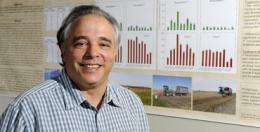Phosphorus runoff can be slowed by changing farming practices, researchers say

(PhysOrg.com) -- Two recent studies by Iowa State University researchers show that phosphorus runoff into Iowa's rivers, streams and lakes can be slowed by farmers changing how they plant and fertilize their crops.
Antonio Mallarino, professor of agronomy, and Matt Helmers, associate professor of agricultural and biosystems engineering, have been studying phosphorous runoff for the past three growing seasons at two research sites that evaluate effects on runoff of tillage practices, bioenergy harvest systems, and phosphorus application using fertilizer or swine manure.
The researchers found that increased ground cover and no-till farming can dramatically reduce phosphorus runoff into Iowa's waterways.
"The main thing that we found out is that agronomic systems that include a permanent grass cover, such as switchgrass, or corn and soybean managed with no-till farming have the least amount of runoff phosphorus," said Mallarino.
"Excessive phosphorous runoff impacts freshwater systems by stimulating algae growth and creating an imbalance that affects fish populations, increases toxin-producing microorganisms, and reduces the aesthetic and recreational value of the system," he added. "That causes the green algal blooms in lakes that are often observed in Iowa."
One study is being done in northwest Iowa using 27 plots that measure 20 feet wide by 100 feet long. Corn/soybean rotation plots were harvested for grain and continuous corn plots also were harvested for stalks. In corn/soybean rotations, the phosphorus needed by both crops was applied once before corn because it is the practice used most by farmers.
Mallarino and Helmer's studies showed that when corn was planted in a corn-after-soybean rotation, phosphorus loss was greatest by using chisel/disk tillage and broadcast commercial fertilizer.
By contrast, when the same corn used a no-till approach and the same amount of phosphorus was applied as either broadcast fertilizer or injected manure, only one-third to one-half of phosphorous was lost in the runoff, although the proportion of dissolved phosphorus increased.
While dissolved phosphorus is the most immediate cause of algae blooms, phosphorus tied to eroded soil also contributes to excess algae growth and long-term water quality impairment, Mallarino said.
In soybean years, when no additional phosphorus was applied, the total phosphorus runoff was less, but the differences between the systems remained.
According to Mallarino, corn yield in the no-till fields was down slightly. After figuring for the fewer number of passes that producers would make in no-till farming, however, the no-till option should make economic sense for farmers concerned about runoff.
A second study conducted over two years near Ames used a rainfall simulation technique and included a comparison of switchgrass harvested for biomass, and various corn production and harvest systems.
Rainfall simulation studies use equipment to mimic natural rainfall and measure nutrient and soil movement used mainly to compare systems or treatments.
This study showed that tillage combined with application of nitrogen-based swine manure for continuous corn and harvesting most of the biomass resulted in the largest phosphorus losses.
The smallest phosphorus loss was for switchgrass, while losses for other systems were intermediate.
Other systems included continuous corn managed with inorganic fertilizers with harvest for total biomass, grain plus a fraction of the residue, or only grain and also corn-soybean rotation managed with swine manure and grain harvest.
The studies showed that using injected swine manure to supply nitrogen to corn grown in rotation with soybeans is a good practice, because the phosphorus applied often supplies the phosphorus needed by both crops.
Applying nitrogen-based manure for continuous corn will only work for so long, cautions Mallarino. Eventually, there will be excess phosphorus on the fields, which brings potential for significant loss with runoff.
Provided by Iowa State University














